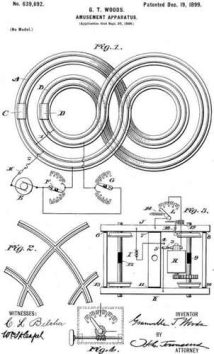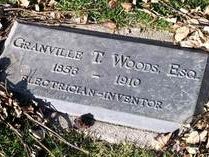
Who is
GTW
About Granville T. Woods
Granville T. Woods was born in Columbus, Ohio, on April 23, 1851, to free African Americans. He held various engineering and industrial jobs before establishing a company to develop electrical apparatus. Known as “Black Edison,” he registered nearly 60 patents in his lifetime, including a telephone transmitter, a trolley wheel and the first electric Roller Coaster known as the ” Figure 8 “. Woods` was thrust into the the national spotlight when he took on Thomas Edison regarding priority over his multiplex induction telegraph invention. Before Woods died in 1910 his revolutionary electrical inventions played a pivotal role in shaping industrial technology and still resonates today.
Early Life
Born in Columbus, Ohio, on April 23, 1851, to free African Americans, Granville T. Woods received a vocational hands-on education in a railroad shop a child, in his teens became a machinist, fireman and, eventually, a railroad engineer in a railroad machine shop. From 1876 to 1878, Woods worked in a steel mill, on a British steam ship and as a railroad Engineer. From 1876 to 1878, Woods lived in New York City, taking courses in engineering and electricity—a subject that he realized, early on, held the key to the future. Back in Ohio in the summer of 1878, Woods was employed for eight months by the Springfield, Jackson and Pomeroy Railroad Company to work at the pumping stations and the shifting of cars in the city of Washington Court House, Ohio. He was then employed by the Dayton and Southeastern Railway Company as an engineer for 13 months. During this period, while traveling between Washington Court House and Dayton, Woods began to form ideas for what would later be credited as his most important invention: the “inductor telegraph.” He worked in the area until the spring of 1880, and then moved to Cincinnati.


Early Inventing Career
Living in Cincinnati, Woods eventually set up his own company to develop, manufacture and sell electrical apparatus, and in 1889, he filed his first patent for an improved steam boiler furnace. His later patents were mainly for electrical devices, including his second invention, an aparatus for transmission of messages. The patent for his device, which combined the telephone and telegraph, was bought by Alexander Graham Bell, and the payment freed Woods to devote himself to his own research. One of his most important inventions was the improved “troller,” a grooved metal wheel that allowed street cars (later known as “trolleys”) to collect electric power from overhead catenary wires.
Induction Telegraph
Woods` Synronous Multiplex system was the first ‘” wireless ” communication signal system on the railroad industry in 1887. Woods` called it the ” Silent watchman “. The device allowed station dispatchers to communicate by voice over telegraph wires, ultimately helping to speed up important communications and, subsequently, preventing crucial errors such as train accidents. Woods defeated Thomas Edison’s lawsuit that challenged his patent, and turned down Edison’s offer for a position with his new state of the art science laboratory at Menlo Park, New Jersey. Thereafter, Woods was often known as the “Black Edison.” After receiving the patent for the multiplex telegraph, Woods was assisted by venture capitalists that reorganized Woods Electric Co. In 1890, dissatisfied with board members, he moved his own research operations to New York City, where he was joined by a brother, Lyates Woods, who also had several inventions of his own. Woods’s next most important invention was the power conduit device in 1901, which is the basis of the so-called “third rail” currently used by electric-powered transit systems. From 1902 to 1905 the orginator of the Air-Brake George Westinghouse purchased Woods`s remarkable improved air brake systems.

Death and Legacy
By the time of his death, on January 30, 1910, Granville T. Woods had invented 15 appliances for electric railways. received nearly 60 patents, many of which were assigned to the major manufacturers of electrical equipment that are a part and parcel of today’s daily life.
GTW is a classic example of an American inventor and innovator. Doesn’t take ” no ” for an answer, and doesn’t quit no matter what obstacles may fall into his path- prejudice, poverty, ridicule from ” experts “, dishonest ” financial backers “, even imprisonment. GTW`S work and fortitude against all odds, ultimately attracted legitimate supporters in the business community, such as high end patent attorneys, who believed in him, and pitched his inventions to the giants of American industry. However , GTW`s non African American supporters couldn`t really explain him simply as a gifted person, in a time period of ” Jim Crow ” and ” Separate but un Equal “. For example, in a very complimentary contemporary newspaper article on GTW NY World April 1892,the generally supportive author had to impart to the reader that ” GTW is coal black, but does not have Negro speech or tendencies “. It also must be noted, that no honorary degrees or honors were bestowed onto GTW, as they were on Thomas Edison- also self taught, with no formal education. Like many other prominent American inventors, GTW had no formal scholastic training in engineering, and was self-taught. The fact is, that people such as GTW, the so called ” self starters “, will find a way of gaining the knowledge they need for a specfic project, and will perform this knowledge gathering task rigorously. One of the key factors in GTW`s self education, was that he was ” cross trained ” in different fields as required, which he then used to synthesize his inventions. For example, many of GTW inventions were a combination of both electrical and mechanical engineering principles. All in all, GTW did amazing well for himself, he commanded respect at a time when African Americans were largely disregarded and ignored, attained some contemporary recognition in the media, and most amazingly, GTW actually managed to get paid by the giants of US industry for some of his inventions- an incredible feat, even today. Mind you, he accomplished all this with no formal education. What if a person with GTW`s natural gifts, was actually sought out and nurtured by the mainstream educational system? I think that person would drop out of school, as the current educational system is largely incapable of encouraging any form of individual innovation. Its urgent that this ” fatal flaw ” in our educational system be corrected very soon, in order for the US to remain a leader in the world economy. While its clearly important to produce technicians, its even more essential to produce innovators. America needs more GTW`s.
Bob Diamond- Brooklyn trolley historian
